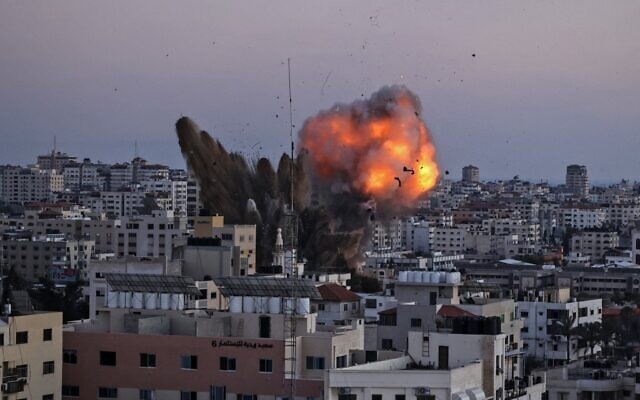
Air force officer: Operations such as this likely ‘make the enemy want
to stop… but we will continue to act for as long as necessary’.
The Israeli Air Force’s massive bombardment of Hamas’s Gaza tunnel network overnight Thursday-Friday destroyed miles of tunnels and killed what the IDF believes to be dozens of Hamas terrorists, in what it hopes will be a decisive phase of the current conflict, an Israeli TV report said late Friday.
“We shut down the Hamas tunnel network,” a military source said.
The bombing was the largest Israeli strike since the outbreak of fighting earlier this week, the IDF said earlier.
The assault was prefaced by a deliberate ruse in which the IDF told the foreign press that Israeli ground forces had entered the Gaza Strip, in order to trick the terror group into sending its operatives into the tunnels — referred to by the IDF as “the metro” — ready to emerge and attack the Israeli troops.
Instead, “the tunnels collapsed on those inside” when the IAF bombed them, the TV report noted.
Some 160 aircraft flying simultaneously conducted the massive attack on the network of tunnels, dug by the Hamas terror group under the northern Gaza Strip, the army said.
According to the Israel Defense Forces, in this air campaign, which lasted nearly 40 minutes, some 450 missiles were dropped on 150 targets in northern Gaza, particularly around the city of Beit Lahiya. In all, 80 tons of explosives were used, the TV report said.
The military said earlier Friday it was still working to determine the extent of the damage caused to the underground infrastructure, which IDF spokesperson Hidai Zilberman told reporters was a “strategic asset” to Hamas, and to ascertain the number of terrorist operatives killed in the strikes.
“Hamas itself may not yet know” how many of its operatives were killed, the TV report said, adding that many Hamas commanders were believed to have been among the gunmen in the tunnels.
Omer Tishler, commander of the IAF’s Nevatim airbase (Channel 12 screenshot)
The commander of the IAF’s Nevatim airbase, Omer Tishler, told Channel 12 that “actions such as this, so damaging to the enemy,” would likely “make the enemy want to stop… but in any case we will continue [to target Hamas] as long as is necessary.”
The tunnels were used by Hamas to fire and store weaponry, including rocket launchers, the TV report said. In an Israeli ground offensive, Hamas fighters emerging from the tunnels would have tried to kill and capture IDF soldiers, as was the case in previous conflicts.
In a statement earlier Friday, Prime Minister Benjamin Netanyahu noted: “I said we would strike Hamas and other terror groups with significant blows, and we are doing so. In the last day we have attacked underground targets. Hamas thought it could hide there, but it cannot.”
Channel 12 called the bombing of the tunnels “the central action” by the Israeli army to date of this week’s conflict, but said the IDF has further such operations ready to carry out if and when necessary.
In addition to the aerial assault, Israeli tanks, artillery cannons and infantrymen on the Gaza border conducted accompanying barrages at Hamas operatives — specifically anti-tank guided missiles and rocket-launching teams — who came out during the assault to conduct attacks on Israeli targets, Zilberman said.
He clarified that the ground troops remained on Israel’s side of the border and did not enter the Gaza Strip, despite earlier claims to the contrary by the IDF, causing incorrect reports of a ground invasion to spread through leading news outlets around the world. The spokesman said the military was investigating what caused the “miscommunication.”
In total, some 500 artillery shells — some flares and some explosives — along with 50 tank shells were fired during this subsequent bombardment.
Zilberman said the operation was the result of large amounts of intelligence and careful planning. The military released video footage (above) showing both its preparations for the attack and some of the strikes themselves on the tunnel network, which the IDF refers to as “the metro.”
The late night bombardment left a trail of damage and sent hundreds of people scrambling for safety in the densely populated Strip.
“As always, the aim is to strike military targets and to minimize collateral damage and civilian casualties,” said Lt. Col. Jonathan Conricus, an Israeli military spokesman. “Unlike our very elaborate efforts to clear civilian areas before we strike high-rise or large buildings inside Gaza, that wasn’t feasible this time.”
In 2014, the tunnel network was described as a threat that necessitated a ground incursion in order to destroy, with dozens of troops killed during the operation, including two soldiers whose bodies are still being held by Hamas.
A spokesman for Hamas’ military wing said the group was not afraid of a ground invasion, which would be a chance “to increase our catch” of Israeli soldiers.
The army continued its bombing campaign on Hamas and Palestinian Islamic Jihad targets in the Strip Friday, targeting rocket production facilities and additional anti-tank guided missile teams.
(Times of Israel).